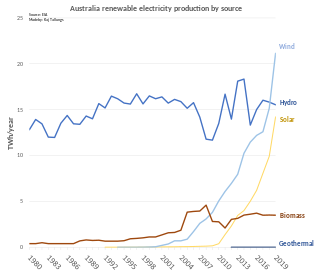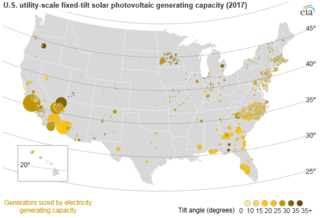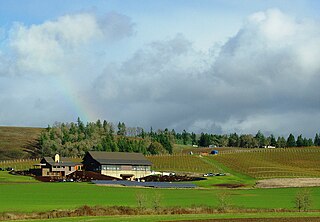Related Research Articles

An eco-industrial park (EIP) is an industrial park in which businesses cooperate with each other and with the local community in an attempt to reduce waste and pollution, efficiently share resources, and help achieve sustainable development, with the intention of increasing economic gains and improving environmental quality. An EIP may also be planned, designed, and built in such a way that it makes it easier for businesses to co-operate, and that results in a more financially sound, environmentally friendly project for the developer.
Renewable Energy Certificates (RECs), also known as Green tags, Renewable Energy Credits, Renewable Electricity Certificates, or Tradable Renewable Certificates (TRCs), are tradable, non-tangible energy commodities in the United States that represent proof that 1 megawatt-hour (MWh) of electricity was generated from an eligible renewable energy resource and was fed into the shared system of power lines which transport energy. Solar renewable energy certificates (SRECs) are RECs that are specifically generated by solar energy.
Energy Conversion Devices (ECD) was an American photovoltaics manufacturer of thin-film solar cells made of amorphous silicon used in flexible laminates and in building-integrated photovoltaics. The company was also a manufacturer of rechargeable batteries and other renewable energy related products. ECD was headquartered in Rochester Hills, Michigan.
BP Solar was a manufacturer and installer of photovoltaic solar cells headquartered in Madrid, Spain, with production facilities in Frederick, MD, India and the People's Republic of China. It was a subsidiary of BP.

Renewable energy in Australia includes wind power, hydroelectricity, solar PV, heat pumps, geothermal, wave and solar thermal energy.

Renewable energy commercialization involves the deployment of three generations of renewable energy technologies dating back more than 100 years. First-generation technologies, which are already mature and economically competitive, include biomass, hydroelectricity, geothermal power and heat. Second-generation technologies are market-ready and are being deployed at the present time; they include solar heating, photovoltaics, wind power, solar thermal power stations, and modern forms of bioenergy. Third-generation technologies require continued R&D efforts in order to make large contributions on a global scale and include advanced biomass gasification, hot-dry-rock geothermal power, and ocean energy. As of 2012, renewable energy accounts for about half of new nameplate electrical capacity installed and costs are continuing to fall.
For solar power, South Asia has the ideal combination of both high solar insolation and a high density of potential customers.

According to preliminary data from the US Energy Information Administration, renewable energy accounted for about 11% of total primary energy consumption and about 17% of the domestically produced electricity in the United States in 2018. Hydroelectric power is currently the largest producer of renewable electricity in the country, generating around 6.5% of the nation's total electricity in 2016 as well as 45.71% of the total renewable electricity generation. The United States is the fourth largest producer of hydroelectricity in the world after China, Canada and Brazil.

The Clean Tech Revolution: The Next Big Growth and Investment Opportunity is a 2007 book by Ron Pernick and Clint Wilder, who say that commercializing clean technologies is a profitable enterprise that is moving steadily into mainstream business. As the world economy faces challenges from energy price spikes, resource shortages, global environmental problems, and security threats, clean technologies are seen to be the next engine of economic growth.

Green Mountain Energy Company is a United States company that offers electricity products, carbon offsets, and "sustainable solutions" to residential and commercial customers.

Yingli, formally Yingli Green Energy Holding Company Limited -. Yingli Green Energy Holding Company Limited, known as "Yingli Solar," is a solar panel manufacturers. Yingli Green Energy's manufacturing covers the photovoltaic value chain from ingot casting and wafering through solar cell production and solar panel assembly. Yingli's photovoltaic module capacity is 4 GWs.

Solar power in the United States includes utility-scale solar power plants as well as local distributed generation, mostly from rooftop photovoltaics. As of the end of 2020, the United States had 97,275 megawatts (MW) of installed photovoltaic and concentrated solar power capacity combined. In 2018, utility scale solar power generated 66.6 terawatt-hours (TWh), 1.66% of total U.S. electricity. During the same time period total solar generation, including estimated small scale photovoltaic generation, was 96.1 TWh, 2.30% of total U.S. electricity. In terms of total cumulative installed capacity, by year end 2017 the United States ranked 2nd in the world behind China. In 2016, 39% of all new electricity generation capacity in the country came from solar, more than any other source and ahead of natural gas (29%). By 2015, solar employment had overtaken oil and gas as well as coal employment in the United States. In 2016, more than 260,000 Americans were employed in the solar industry.

Cathy Zoi is CEO of EVGo the US's largest fast charging network for electric vehicles. She is the former Assistant Secretary for Energy Efficiency and Renewable Energy (EERE) at the U.S. Department of Energy.

Solar power in Oregon has been growing in recent years due to new technological improvements and a variety of regulatory actions and financial incentives enacted by the state government.
E+Co is a non-governmental organization based in Bloomfield, New Jersey, United States, that from its founding in 1994 to its restructuring in 2012 made over 250 clean energy investments in developing countries. Over these 18 years, E+Co maintained field offices in San Jose, Costa Rica, Bangkok, Thailand, Dar es Salaam, Tanzania and Accra, Ghana. The company's name is pronounced, "E and Co".
Solar power in Georgia on rooftops can provide 31% of all electricity used in Georgia.

Solar power in New Hampshire provides a small percentage of the state's electricity. State renewable requirements and declining prices have led to some installations. Photovoltaics on rooftops can provide 53.4% of all electricity used in New Hampshire, from 5,300 MW of solar panels, and 72% of the electricity used in Concord, New Hampshire. A 2016 estimate suggests that a typical 5 kW system costing $25,000 before credits and utility savings will pay for itself in 9 years, and generate a profit of $34,196 over the rest of its 25-year life. A loan or lease provides a net savings each year, including the first year. New Hampshire has a rebate program which pays $0.75/W for residential systems up to 5 kW, for up to 50% of the system cost, up to $3,750. However, New Hampshire's solar installation lagged behind nearby states such as Vermont and New York, which in 2013 had 10 times and 25 times more solar, respectively.

Darren T. Kimura is an American businessman, inventor, and investor. He is best known as the inventor of Micro Concentrated solar power (CSP) technology otherwise known as MicroCSP.

Real Goods Trading Corporation is a retail and wholesale e-commerce business located in Ukiah, California that sells renewable energy systems and resources for people interested in living off the grid or with a low environmental impact.
Hanwha Q Cells Co., Ltd., and "Hanwha Q Cells & Advanced Materials Corp.", commonly known as Q Cells or Hanwha Q Cells, are manufacturers of photovoltaic (PV) solar cells. They are headquartered in Seoul, South Korea. Its technology and innovation center is located in Thalheim, Germany. Both companies are subsidiaries of Hanwha Solutions, an affiliate of the Hanwha Group. The companies operate under brand Q Cells. CEO of the company is Hee Cheul (Charles) Kim.
References
- ↑ Kellar, Andrew. "Green Launching Pad". Green Launching Pad. Archived from the original on 2010-02-08. Retrieved 2012-08-27.
- ↑ McCord, Michael (2010-08-30). "Green Launching Pad having an impact". Seacoast Online. Archived from the original on 2016-03-04. Retrieved 2012-08-30.
- 1 2 McCord, Michael (2012-05-04). "As federal dollars dry up, Green Launching Pad looks to reinvent itself". New Hampshire Business Review. Archived from the original on 2012-07-15. Retrieved 2012-09-01.
- ↑ Manning, Colin (2011-04-28). "Gov. Lynch, U.S. Energy Secretary Chu, UNH President Huddleston Announce Companies Chosen for Green Launching Pad". UNH Media Relations. Retrieved 2012-08-30.
- ↑ "GLP 2.5 Companies". Green Launching Pad Website. Buddy Press. Archived from the original on 2012-09-22. Retrieved 2012-08-30.